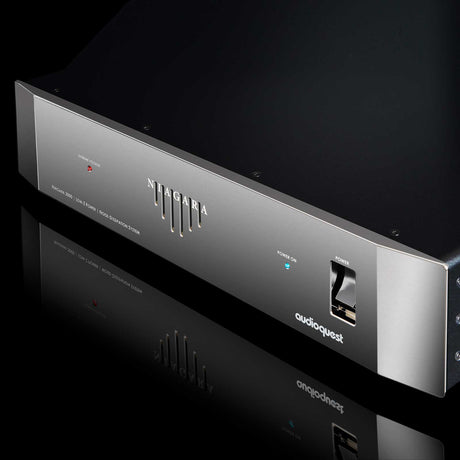
On Bi-Wiring and Power Conditioning
AudioQuest's Niagara 3000 proves to be a first of its kind — the first power conditioner Alex Halberstadt doesn't hate, that is.
Kabel połączeniowy audio
Często wybór pomiędzy zakończeniem kabli głośnikowych za pomocą widełek spadowych a wtykami bananowymi sprowadza się do osobistych preferencji. Jednak zgodne z normami UE izolowane zaciski stosowane w niektórych wzmacniaczach mocy często utrudniają, jeśli nie uniemożliwiają, dokręcenie widełek spadowych z dużym momentem obrotowym lub naciskiem. W takich przypadkach złącze bananowe AudioQuest jest lepszym wyborem, a może być jedynym wyborem.
AudioQuest przeprowadziło dość szerokie badanie współczesnych producentów wzmacniaczy, aby określić, czy widełki czy banany będą najbardziej odpowiednie dla danej marki i modelu wzmacniacza. Prosimy skontaktuj się z nami, podaj markę i model wzmacniacza, a my odpowiemy z optymalnym typem złącza.
W tym przypadku zazwyczaj zalecamy złącze U-Spade lub bananowe. Jednak mimo że po tej stronie kabla jest mniej wagi i nacisku (szczególnie w przypadku zestawów BiWire), ważne jest, aby zwrócić uwagę na konstrukcję zacisku. Jeśli złącze bananowe nie może być w pełni osadzone w zacisku, zalecamy jedno z naszych złączy spadowych.
Solidne przewodniki z miedzi o perfekcyjnej powierzchni (PSC+)
Solidne przewodniki zapobiegają interakcji elektrycznej i magnetycznej pomiędzy włóknami. PSC+ Solid-Copper minimalizuje zniekształcenia spowodowane granicami ziaren i maksymalizuje liniowe rozpraszanie szumów RF.
Poziom 6 Rozpraszanie Szumów: ZERO-Tech + Carbon/Sieć Grafenowa + Kontrola Kierunku
Szumy radiowe z komórek, WiFi i satelitów są wszędzie. Liniowe Rozpraszanie Szumów AQ na Poziomie 6 obejmuje carbon oraz sieć rezystancyjną z grafenu, kierunkowo kontrolowane przewodniki i posrebrzane druty odprowadzające, znacznie minimalizując efekty maskowania szumów RF.
ZERO-Tech (Bez Charakterystycznej Impedancji) dla Liniowego, Szerokopasmowego Rozpraszania Szumów
Jedynym sposobem na uniknięcie efektów niedopasowania charakterystycznej impedancji między kablem a jego źródłem i obciążeniem jest zapobieganie posiadaniu przez kabel charakterystycznej impedancji. ZERO-Tech osiąga to poprzez eliminację pola elektrostatycznego między przewodnikami sygnału wysokiego i niskiego, umożliwiając liniowe (konsekwentne od oktawy do oktawy) Rozpraszanie Szumów Radiowych (RF) oraz niekompresowane transjenty. Aby zachować pełną izolację przewodników sygnału ZERO-Tech, dołączony jest podwójny pakiet DBS 72V dla kabli XLR Pegasus, ThunderBird, FireBird i Dragon.
System Polaryzacji Dielektryka 72V (DBS)
Izolacja jest również dielektrykiem, który może działać jak filtr bocznikowy. Polaryzacja minimalizuje szumy dielektryczne i liniuje filtr, znacznie poprawiając szerokopasmowe rozpraszanie indukowanych szumów RF.
Izolacja z FEP Air-Tube
Przewodniki dodatnie korzystają z prawie żadnego kontaktu między metalem a jego izolacją FEP, która wyróżnia się doskonałą stałą dielektryczną i minimalnym zakłóceniem sygnału. Przewodniki ujemne korzystają z celowo „stratnej izolacji” — brak powietrza i brak FEP pomaga maksymalizować różne zadanie połączenia ujemnego.
6% Posrebrzane Druty Odprowadzające RF
Kierunkowo kontrolowane posrebrzane druty odprowadzające RF dodatkowo zapewniają właściwe i efektywne rozpraszanie indukowanego szumu radiowego dla czystszego, bardziej naturalnego dźwięku.
Miedziane Drążki Odprowadzające RF
Uziemione miedziane drążki maksymalizują rozpraszanie szumów poprzez zapobieganie pojemnościowemu sprzężeniu RF z przewodnikami.
Wtyki Srebrzone na Miedzi Czerwonej
Najlepsze wtyki AudioQuest posiadają doskonałe srebrzenie zawieszone (nie toczone) bezpośrednio na miedzi czerwonej o ekstremalnej czystości, aby zapewnić niezakłócony transfer sygnału.
ThunderBird XLR > XLR Od $1,550.00 Pokaż szczegóły | Pegasus XLR > XLR Od $877.50 Pokaż szczegóły | FireBird XLR > XLR Od $2,750.00 Pokaż szczegóły | Dragon XLR > XLR Od $4,450.00 Pokaż szczegóły |
|---|